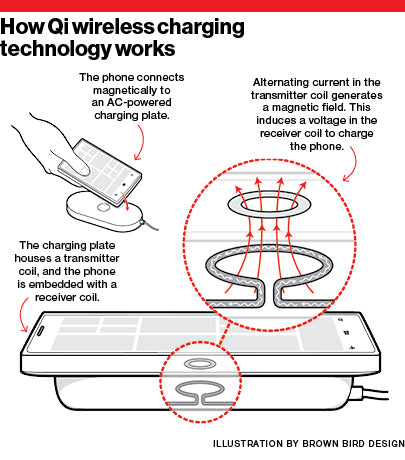Cutting the Cord: The Future of Charging is Wireless!
In this post-
Unleash the Future of Power: Cut the Cord and Charge Ahead!
Discover the electrifying world of wireless charging that's rewriting the rules of power! 🚀🔋
Ever dreamt of a life where your phone charges effortlessly, no cords, no hassle? It's not just a dream—it's the wireless revolution, and it's here to stay! 📲⚡
🔍 Dive into the Wireless Wonderland:
- Imagine a life free from the shackles of charging cables—where cafes, restaurants, even your furniture, become power hubs!
🌐 The Power Play:
- Over four billion users already know the desperation of a dying battery. Now, picture a world where five billion people say goodbye to the nightly wall-hugging ritual.
🚗 Drive into the Future:
- Electric vehicles gliding into parking spots, seamlessly aligning with charging pads—no attendants, no fuss. The future of EV charging is as simple as parking.
💡 The Science Behind the Magic:
- Explore the fascinating journey from Michael Faraday's magnetic dreams to Tesla's wireless feats. It's not just charging; it's a century-old dance of magnetic fields!
🌐 Top 10 Burning Questions:
- How does it work? Is it efficient? What about electric vehicles? Get answers to the most pressing questions about the wireless wave sweeping across technology!
🚀 Join the Charge Ahead Movement:
- It's not just about cutting cords; it's about powering up a future where convenience meets sustainability. Are you ready to join the charge ahead movement?
Don't be left in the cords—cut loose and dive into the wireless era! Embrace the power, embrace the future. 🔌🔜 #WirelessRevolution #CutTheCord #ChargeAhead 🚀⚡
1. The Mobile Revolution:
- Over four billion mobile phone users globally, with projections reaching five billion by the end of the decade.
2. The Desperation of a Dying Battery:
- We've become dependent on our phones, facing the familiar panic of a dying battery, especially in the midst of a busy day.
3. The Evolution of Charging:
- Mobile devices last about a day on a charge, tying us to walls for the better part of the night.
4. Enter Wireless Charging:
- What if charging our phones was as convenient as using them? Enter wireless charging, a game-changer in power delivery.
5. The Rise of Wireless Charging:
- From cafes to fast-food joints, even IKEA furniture, wireless charging is becoming ubiquitous.
6. The Science Behind It:
- Wireless charging, particularly inductive charging, traces its roots back to Michael Faraday's discoveries in the mid-1800s.
7. Tesla's Influence:
- Tesla demonstrated resonant inductive coupling in the late 1800s, a breakthrough leading to modern electrical motors.
8. Challenges and Solutions:
- Inductive chargers consist of simple components: AC current, a generator, and a transmission coil. Challenges include efficiency and standardized designs.
9. The Impact on Electric Vehicles:
- Inductive charging could revolutionize EVs, making charging as simple as parking and aligning the vehicle with a charging pad.
10. The Power Dilemma:
- While convenient, wireless charging poses efficiency challenges. A study shows wireless chargers have an efficiency of around 59.4%, raising concerns about increased energy demands.
Top 10 Questions about Wireless Charging:
1. How does wireless charging work?
- Wireless charging uses inductive coupling, transferring power from a source to a device without a direct wired connection.
2. What is resonant inductive coupling?
- Tesla demonstrated resonant inductive coupling, where two coils with identical resonant frequencies efficiently transfer power.
3. When did wireless charging become viable for consumer electronics?
- In the 1990s and 2000s, wireless charging became feasible for consumer electronics, initially seen in items like wireless charging toothbrushes and later in mobile phones.
4. What are the main components of an inductive charger?
- An inductive charger consists of AC current, a generator, and a transmission coil, creating a magnetic field that induces a current in the receiving coil of the device.
5. How efficient is wireless charging?
- Efficiency varies, with studies indicating around 59.4% efficiency for some wireless chargers, raising concerns about the additional load on power grids.
6. Can wireless charging work for electric vehicles?
- Yes, inductive charging has the potential to simplify EV charging, making it as easy as parking over a charging pad.
7. What are the implications of widespread wireless charging?
- The convenience of wireless charging needs to be balanced with its impact on energy consumption. Inductive charging could significantly increase power demands.
8. Is there ongoing research to improve wireless charging?
- Yes, researchers are continually exploring ways to enhance wireless charging efficiency. Recent developments show promising results, with some systems operating at 90% efficiency.
9. How could wireless charging impact infrastructure?
- The integration of wireless charging infrastructure in public spaces, furniture, and vehicles could reshape how we approach power delivery.
10. What's the future of wireless charging?
- The future could see widespread integration of wireless charging technology, not only for phones but also for laptops, furniture, and electric vehicles, with ongoing efforts to address efficiency concerns.

